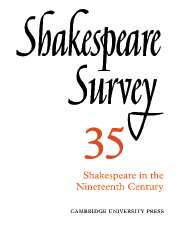Book contents
- Frontmatter
- Before the Shakespeare Revolution: Developments in the Study of Nineteenth-Century Shakespearian Production
- The Meininger Company and English Shakespeare
- Shakespeare at the Burgtheater: From Heinrich Anschütz to Josef Kainz
- Shakespeare on the Melbourne Stage, 1843-61
- Shakespeare in Hazlitt’s Theatre Criticism
- Characterization of the Four Young Lovers in A Midsummer Night’s Dream
- Queenly Shadows: On Mediation in Two Comedies
- Language, Theme, and Character in Twelfth Night
- The Art of the Comic Duologue in Three Plays by Shakespeare
- ‘Spanish’ Othello: The Making of Shakespeare’s Moor
- Ferdinand and Miranda at Chess
- Shakespeare’s Latin Citations: The Editorial Problem
- The Theatre at Christ Church, Oxford, in 1605
- Interpretations of Shakespearian Comedy, 1981
- The Year's Contributions to Shakespearian Study 1 Critical Studies
- 2 Shakespeare’s Life, Times and Stage
- 3 Textual Studies
- Index
- Plate Section
Language, Theme, and Character in Twelfth Night
Published online by Cambridge University Press: 28 March 2007
- Frontmatter
- Before the Shakespeare Revolution: Developments in the Study of Nineteenth-Century Shakespearian Production
- The Meininger Company and English Shakespeare
- Shakespeare at the Burgtheater: From Heinrich Anschütz to Josef Kainz
- Shakespeare on the Melbourne Stage, 1843-61
- Shakespeare in Hazlitt’s Theatre Criticism
- Characterization of the Four Young Lovers in A Midsummer Night’s Dream
- Queenly Shadows: On Mediation in Two Comedies
- Language, Theme, and Character in Twelfth Night
- The Art of the Comic Duologue in Three Plays by Shakespeare
- ‘Spanish’ Othello: The Making of Shakespeare’s Moor
- Ferdinand and Miranda at Chess
- Shakespeare’s Latin Citations: The Editorial Problem
- The Theatre at Christ Church, Oxford, in 1605
- Interpretations of Shakespearian Comedy, 1981
- The Year's Contributions to Shakespearian Study 1 Critical Studies
- 2 Shakespeare’s Life, Times and Stage
- 3 Textual Studies
- Index
- Plate Section
Summary
With the English language’s growth in power and importance in the sixteenth and seventeenth centuries came a zest for theorizing about the truth of words. Some writers continued to stress the benefits of eloquence, one of the more recent acquisitions of English. Francis Meres asserts in Palladis Tamia (1598) that ‘though the naked truth be welcome, yet it is more gratefull, if it come attired and adorned with fine figures, and choice phrases’ (fol. 252). Sixteenth-century grammar schools taught moral truth through eloquence, emphasizing authors’ who at the same time polish and teach language and morals’. The compatibility of words and motives was accepted in guides to conduct such as William Martyn’s Youths Instruction (1612) which states that ‘the inward cogitations of a mans hart are publikely revealed by his speech, and outward actions’ (p. 39). But Martyn’s axiom can be juxtaposed with any number of versions of Politeuphuia’s ‘The typ of the tongue soundeth not alwayes the depth of the heart.’ And although rhetoric, the art of eloquence, could be seen as a means for communicating the truth effectively, the new fashionable teachers of logic and rhetoric, Ramus and his school, were inclined to treat rhetoric as the art of dissimulation. ‘Matter’ became more important than words. Bacon writes that words ‘are but the images of matter; and except they have life of reason and invention, to fall in love with them is all one as to fall in love with a picture’.
- Type
- Chapter
- Information
- Shakespeare Survey , pp. 79 - 86Publisher: Cambridge University PressPrint publication year: 1982
- 1
- Cited by

